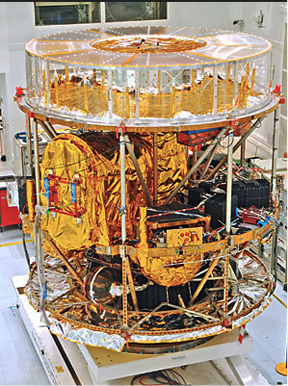
EUMETSAT's MSG-3 satellite, photo courtesy of Thales Alenia Space.
...to French Guiana on April 13th for a June 19, 2012, launch from Kourou, the European Space Port, to ensure continuity of real-time weather monitoring from geostationary orbit 36,000 km from Earth. This service, currently provided by Meteosat-9 and the aging Meteosat-8, launched in August 2002, is vital to ensure the safety of lives, property and infrastructure, particularly in situations of severe weather. The launch of MSG-3 is timed for the smooth transition from Meteosat-8, which has greatly exceeded its expected lifetime.
After the switching on and testing of its systems and instruments, MSG-3 will be renamed Meteosat-10. Together with Meteosat-9, launched in December 2005, it will form the two-satellite Meteosat Second Generation system which EUMETSAT operates to support weather forecasters in one of their most challenging tasks, called “nowcasting”. This involves detecting in real time rapidly developing high impact phenomena like thunderstorms or fog, predicting their evolution a few hours ahead and issuing warnings accordingly. Nowcasting requires very frequent high-quality images of the atmosphere that only advanced geostationary satellites can deliver from space.
MSG-3 (Meteosat-10) will provide full disk images of the European and African continents, as well as parts of the Atlantic and Indian oceans every 15 minutes, while Meteosat-9 will deliver more frequent images over Europe every five minutes. Furthermore, MSG-3 will expand the 35-year climate records accumulated by the Meteosat series since 1977 and deliver unique information on wind in altitude, extracted from the observed displacement of cloud tops and water vapour patterns. The MSG satellite series is the result of the successful cooperation model with the European Space Agency (ESA), which develops the satellites according to EUMETSAT’s requirements and procures recurrent units on the latter’s behalf from the European space industry. All MSG satellites are manufactured by a European consortium led by Thales Alenia Space.

